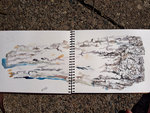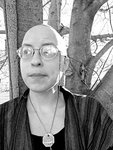

Last year, I bought a child’s folding chair and a new sketchbook, and started taking them up the hill by my house to sit and stare into various clumps of weeds and native wildflowers. I had decided that I would draw every species of plant that can be found along the walking path in Frogtown Farm Park.
Even on a small plot of land, this is an inherently ridiculous goal (part of what I like about it.) I hold on to a hope of accomplishing it some day, but that’s not the point. The point is that plants aren’t active movers and make few demands, so it’s easy to spend a long, quiet time getting to know them. If there’s a global pandemic and you are the only human in your home, the plants can provide good company and a change of setting.
To draw is to acknowledge the value and dignity of your subject. This dead leaf/patch of moss/wilting flower is worth observing closely and from several angles; it is worth understanding and remembering. The act of writing this, right now, accidentally helped me realize why I very often struggle for motivation to draw the ideas that come purely from my own head. Oops! Luckily, art from observation and art from imagination feed one another. Ideas come from the world. I mean from getting in there and really splashing around.
If you have made any kind of art, you have experienced the gap between your intention and what actually comes out. It can be heartbreaking: a glorious vision, some scribbles on paper, the distance between them. Your inspiration can fall right through – which is a shame, because the gap shrinks with practice. I don’t believe it ever goes away, but that’s ok. Eventually you might fall in love with the things that come out of there. That’s where weird, spontaneous beauty lives – the kind you don’t see or imagine until it’s there on the paper, messing up your plans.
There’s also information in the gap itself. A while ago I went out drawing with a friend. Looking back at a sketch from last October, they commented on the color of a leaf (for example, a particular silvery blue) that they couldn’t quite get from their little watercolor set. Months later, they had a lovely drawing and this color was one of many details of a plant they still remembered and noticed out in the world.
I love people, but regular conversations with strangers and loved ones alike make me anxious because I manage to truly say what I mean to say, in the way I meant to say it, maybe 15% of the time. Most of the remaining 85% is close enough, but I’m stymied by the gap. Possibly everyone feels this way, but I’m not sure how to find out. (This is a joke.) Art is both an alternate form of communication, and a place to remember that there are places where the concepts of “failure” and “success” aren’t especially relevant.
I like to try painting the things that I have no idea how to paint:
> Sunlight in fine strands of milkweed fluff
> The infinite texture of tree bark (seriously, take a look at it!)
> How long, curly and brittle the grass gets at the top of the hill in November, right before the snow comes
In art, it’s fun to throw myself at an impossible task. It’s fun to be brave. Maybe there’s a road between this feeling and courage in other parts of life, too.
Comments
No comments on this item Please log in to comment by clicking here